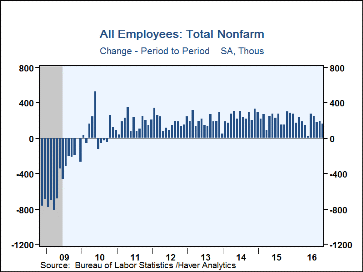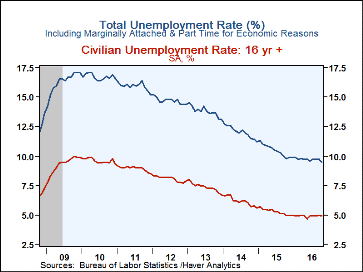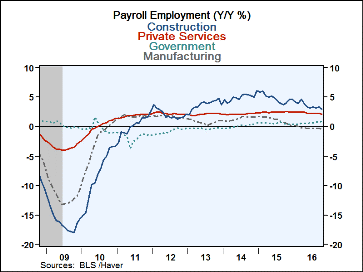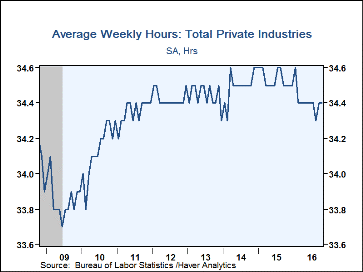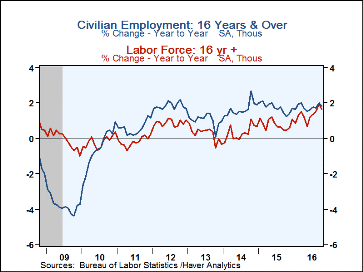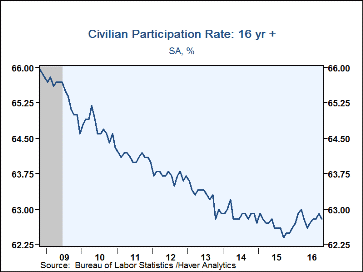 Global| Nov 04 2016
Global| Nov 04 2016U.S. Payroll Increase Fades; Earnings Growth Improves
by:Tom Moeller
|in:Economy in Brief
Summary
Nonfarm payroll employment increased 161,000 (1.7% y/y) during October following revised gains of 191,000 and 176,000 in September and August. These had been reported as 156,000 and 167,000, respectively. A 174,000 rise in employment [...]
Nonfarm payroll employment increased 161,000 (1.7% y/y) during October following revised gains of 191,000 and 176,000 in September and August. These had been reported as 156,000 and 167,000, respectively. A 174,000 rise in employment had been expected in the Action Economics Forecast Survey. Weaker job creation was logged by each major employment category, except mining & government. The Labor Department indicated that Hurricane Matthew "affected parts of the East Coast during the October reference period." From the household survey, the unemployment rate edged lower to an expected 4.9%. The overall unemployment rate, including marginally attached and those working part-time for economic reasons, fell to 9.5%. Average hourly earnings rose 0.4% (2.8% y/y). A 0.3% rise was expected.
From the payroll employment survey, the 161,000 jobs rise was the smallest since May. It lessened three-month growth to an average 176,000, the least since June. Factory sector employment declined 9,000 (-0.4% y/y), down for the third consecutive month. Construction sector employment increased 11,000 (3.0% y/y), half of the September increase. Mining sector employment declined 2,300 (-14.5% y/y).
Private service sector jobs increased 142,000 (2.1% y/y), the weakest rise since May. Education & health services employment rose 52,000 (2.7% y/y), as health care jobs alone improved 30,500 (2.7% y/y). Professional & business services hiring gained 43,000 (2.7% y/y). Monthly increases have been volatile, but three-month average growth has been fairly steady at 50,000. Temporary help jobs rose 6,400 (1.3% y/y) following a 31,000 spurt. Financial activities jobs increased 14,000 (2.1% y/y) following a 4,000 uptick. Employment in the trade, transportation & utilities sector rose 13,000 (1.5% y/y), but was held back by an 1,100 decline (+1.8% y/y) in retail sector employment. Leisure & hospitality employment increased a modest 10,000 (2.0% y/y), half this year's 22,000 monthly average. Information services jobs grew 4,000 (0.4% y/y) after no change over the prior two months.
Government sector employment increased 19,000 (0.9% y/y), and roughly equaled this year's 20,000 monthly average. Federal government hiring increased 12,000. Year-to-year growth of 2.3% was higher than the 0.7% gain during all of last year, and declines back to 2011. Local government jobs rose 4,000 (1.0% y/y) while state government hiring improved 3,000 (0.2% y/y).
The length of the average workweek has unchanged at 34.4 hours. The factory sector workweek edged higher to 40.8 hours, but in construction, it held steady at 39.2 hours. The private service sector workweek also was stable at 33.3 hours. That reflected an easier 37.4 hours in in financial activities, and 35.9 hours in the information sector, down from a high of 36.7 during all of 2014. Hours in professional & business services of 36.2 was the most since January, and compared to a stable 26.1 hours in leisure & hospitality.
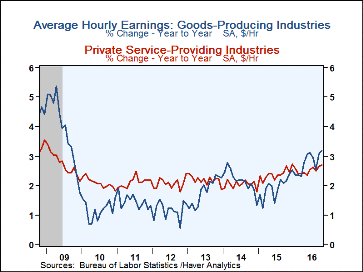 Average hourly earnings increased 0.4% and compared to an
expected 0.3% rise. It was the strongest gain in three months, and y/y growth of
2.8% was the firmest since Q2 2009. Factory sector earnings rose 3.3% y/y, up
from 1.0% in 2012. Earnings in construction gained 3.2% y/y, up from a 2011 low
of 0.9%. Private service sector earnings grew 2.7% y/y, faster than 2.0% in 2014.
Average hourly earnings increased 0.4% and compared to an
expected 0.3% rise. It was the strongest gain in three months, and y/y growth of
2.8% was the firmest since Q2 2009. Factory sector earnings rose 3.3% y/y, up
from 1.0% in 2012. Earnings in construction gained 3.2% y/y, up from a 2011 low
of 0.9%. Private service sector earnings grew 2.7% y/y, faster than 2.0% in 2014.
From the household employment survey, the fall in the unemployment rate to 4.9% reflected a 43,000 decline (+1.8% y/y) in employment, the first fall in six months, and a 195,000 drop (+1.7% y/y) in the labor force. The labor force participation rate fell to 62.8%, but was stable with the elevated Q3 average. The average duration of unemployment fell to 27.2 weeks. It was the lowest level since May and down from 39.4 in 2012.
The teenage unemployment rate of 15.6% compared to 25.9% during all of 2010. Individuals aged 20-24 faced an 8.4% jobless rate versus 15.5% in 2010. Those over age 25 were 4.0% unemployed, down from 8.2% in 2010.
By educational attainment, individuals with less than a high school diploma were 7.3% unemployed. High school graduates with no college were 5.5% out of work. Those with less than a bachelor's degree experienced 3.8% unemployment, while college graduates were 2.6% unemployed.
The labor market data are contained in Haver's USECON database. Detailed figures are in the EMPL and LABOR databases. The expectations figure is in the AS1REPNA database.
| Employment: (SA, M/M Change, 000s) | Oct | Sep | Aug | Oct Y/Y | 2015 | 2014 | 2013 |
|---|---|---|---|---|---|---|---|
| Payroll Employment | 161 | 191 | 176 | 1.7 | 2.1% | 1.9% | 1.6% |
| Previous | -- | 156 | 167 | -- | -- | -- | -- |
| Manufacturing | -9 | -8 | -16 | -0.4 | 1.1 | 1.4 | 0.8 |
| Construction | 11 | 23 | -6 | 3.0 | 4.8 | 5.0 | 3.7 |
| Private Service-Producing | 142 | 174 | 158 | 2.1 | 2.5 | 2.1 | 2.1 |
| Government | 19 | 3 | 44 | 0.9 | 0.5 | 0.0 | -0.3 |
| Average Weekly Hours - Private Sector | 34.4 | 34.4 | 34.3 | 34.5 | 34.5 | 34.5 | 34.5 |
| Private Sector Average Hourly Earnings (%) | 0.4 | 0.3 | 0.1 | 2.8 | 2.3 | 2.1 | 2.1 |
| Unemployment Rate (%) | 4.9 | 5.0 | 4.9 | 5.0 | 5.3 | 6.2 | 7.4 |
Tom Moeller
AuthorMore in Author Profile »Prior to joining Haver Analytics in 2000, Mr. Moeller worked as the Economist at Chancellor Capital Management from 1985 to 1999. There, he developed comprehensive economic forecasts and interpreted economic data for equity and fixed income portfolio managers. Also at Chancellor, Mr. Moeller worked as an equity analyst and was responsible for researching and rating companies in the economically sensitive automobile and housing industries for investment in Chancellor’s equity portfolio. Prior to joining Chancellor, Mr. Moeller was an Economist at Citibank from 1979 to 1984. He also analyzed pricing behavior in the metals industry for the Council on Wage and Price Stability in Washington, D.C. In 1999, Mr. Moeller received the award for most accurate forecast from the Forecasters' Club of New York. From 1990 to 1992 he was President of the New York Association for Business Economists. Mr. Moeller earned an M.B.A. in Finance from Fordham University, where he graduated in 1987. He holds a Bachelor of Arts in Economics from George Washington University.


